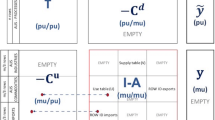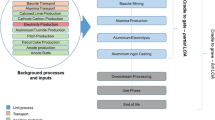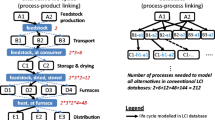Abstract
Purpose
Life cycle assessment (LCA) is inherently complex and time consuming. The compilation of life cycle inventories (LCI) using a traditional process analysis typically involves the collection of data for dozens to hundreds of individual processes. More comprehensive LCI methods, such as input-output analysis and hybrid analysis can include data for billions of individual transactions or transactions/processes, respectively. While these two methods are known to provide a much more comprehensive overview of a product’s supply chain and related environmental flows, they further compound the complex and time-consuming nature of an LCA. This has limited the uptake of more comprehensive LCI methods, potentially leading to ill-informed environmental decision-making. A more accessible approach for compiling a hybrid LCI is needed to facilitate its wider use.
Methods
This study develops a model for streamlining a hybrid LCI by automating various components of the approach. The model is based on the path exchange hybrid analysis method and includes a series of inter-related modules developed using object-oriented programming in Python. Individual modules have been developed for each task involved in compiling a hybrid LCI, including data processing, structural path analysis and path exchange or hybridisation.
Results and discussion
The production of plasterboard is used as a case study to demonstrate the application of the automated hybrid model. Australian process and input-output data are used to determine a hybrid embodied greenhouse gas emissions value. Full automation of the node correspondence process, where nodes relating to identical processes across process and input-output data are identified, remains a challenge. This is due to varied dataset coverage, different levels of disaggregation between data sources and lack of detail of activities and coverage for specific processes. However, by automating other aspects of the compilation of a hybrid LCI, the comprehensive supply chain coverage afforded by hybrid analysis is able to be made more accessible to the broader LCA community.
Conclusions
This study shows that it is possible to automate various aspects of a hybrid LCI in order to address traditional barriers to its uptake. The object-oriented approach used enables the data or other aspects of the model to be easily updated to contextualise an analysis in order to calculate hybrid values for any environmental flow for any variety of products in any region of the world. This will improve environmental decision-making, critical for addressing the pressing global environmental issues of our time.








Similar content being viewed by others
References
Alic D, Omanovic S, Giedrimas V (2016) Comparative analysis of functional and object-oriented programming. Paper presented at the 39th International Convention on Information and Communication Technology, Electronics and Microelectronics (MIPRO), Opatija, Croatia, May 30th - June 3rd
Atlassian (2017) SourceTree
Augspurger T et al (2017) Python Data Analysis Library vol 0.20.2
Baboulet O (2009) Path exchange method for hybrid life-cycle assessment Norwegian University of Science and Technology
Blengini GA, Di Carlo T (2010) The changing role of life cycle phases, subsystems and materials in the LCA of low energy buildings. Energ Buildings 42:869–880
Bontinck P-A (2018) Summary of path exchange hybrid life cycle greenhouse gas emissions inventory for Plasterboard in Australia. Figshare. https://doi.org/10.6084/m9.figshare.5687770. Accessed 23 Feb 2018
Bontinck P-A, Crawford RH, Stephan A (2017) Improving the uptake of hybrid life cycle assessment in the construction industry. Procedia Engineering 196:822–829
Crama Y, Defourny J, Gazon J (1984) Structural decompostion of multipliers in input-output or social accounting matrix analysis. Econ Appl 37:215–222
Crawford RH (2008) Validation of a hybrid life cycle inventory analysis method. J Environ Manag 88:496–506
Crawford RH (2011) Life cycle assessment in the built environment. Spon Press, London
Crawford RH, Bartak EL, Stephan A, Jensen CA (2016) Evaluating the life cycle energy benefits of energy efficiency regulations for buildings. Renew Sust Energ Rev 63:435–451
Crawford RH, Bontinck P-A, Stephan A, Wiedmann T (2017) Towards an automated approach for compiling hybrid life cycle inventories. Procedia Engineering 180:157–166
Crawford RH, Bontinck P-A, Stephan A, Wiedmann T, Yu M (2018a) Hybrid life cycle inventory methods—a review. J Clean Prod 172:1273–1288
Crawford RH, Stephan A, Bontinck P-A (2018b) Improving the life cycle environmental performance of Australian construction projects. https://figshare.com/projects/Improving_the_life_cycle_environmental_performance_of_Australian_construction_projects/27433. Accessed 11 May 2018
Defourny J, Thorbecke E (1984) Structural path analysis and multiplier decomposition within a social accounting matrix framework. Econ J 94:111–136
Dixit MK (2017) Life cycle embodied energy analysis of residential buildings: a review of literature to investigate embodied energy parameters. Renew Sust Energ Rev 79:390–413
Dubois PF (2005) Maintaining correctness in scientific programs. Comput Sci Eng 7:80–85
Eurostat (2008) Eurostat manual of supply, use and input-output tables. Office for Official Publications of the European Communities, Luxembourg
Gibon T, Schaubroeck T (2017) Lifting the fog on characteristics and limitations of hybrid LCA—a reply to “Does hybrid LCA with a complete system boundary yield adequate results for product promotion?” by Yi Yang. Int J Life Cycle Assess 22(3):456–406. https://doi.org/10.1007/s11367-016-1256-9 Int J Life Cycle Assess 22:1005–1008
Grant T (2016) AusLCI database manual, vol 1.26, 1.26 ed. Australian Life Cycle Assessment Society (ALCAS)
Hammond G, Jones C (2008) Inventory of carbon & energy: ICE. Sustainable Energy Research Team, Department of Mechanical Engineering, University of Bath, Bath
Junnila S (2004) The environmental impact of an office building throughout its life cycle. PhD thesis, Helsinki University of Technology Construction Economics and Management
Lenzen M (2000) Errors in conventional and input-output-based life-cycle inventories. J Ind Ecol 4:127–148
Lenzen M, Crawford RH (2009) The path exchange method for hybrid LCA. Environ Sci Technol 43:8251–8256
Lenzen M, Geschke A, Wiedmann T, Lane J, Anderson N, Baynes T, Boland J, Daniels P, Dey C, Fry J, Hadjikakou M, Kenway S, Malik A, Moran D, Murray J, Nettleton S, Poruschi L, Reynolds C, Rowley H, Ugon J, Webb D, West J (2014) Compiling and using input–output frameworks through collaborative virtual laboratories. Sci Total Environ 485-486:241–251
Leontief W (1970) Environmental repercussions and the economic structure: an input-output approach. Rev Econ Stat 52:262–271
Lutz M (2013) Learning Python, 5th edn. O'Reilly Media, Sebastopol
Majeau-Bettez G (2014) ecospold2matrix: a Python class for recasting Ecospold2 LCA datasets into Leontief matrix representations or supply and use tables. GitHub
Majeau-Bettez G, Strømman AH, Hertwich EG (2011) Evaluation of process- and input-output-based life cycle inventory data with regard to truncation and aggregation issues. Environ Sci Technol 45:10170–10177
Miotto R, Wang F, Wang S, Jiang X, Dudley JT (2017) Deep learning for healthcare: review, opportunities and challenges. Brief Bioinform. https://doi.org/10.1093/bib/bbx044
Oregi X, Hernandez P, Gazulla C, Isasa M (2015) Integrating simplified and full life cycle approaches in decision making for building energy refurbishment: benefits and barriers. Buildings 5:354–380
Pauliuk S, Majeau-Bettez G, Mutel CL, Steubing B, Stadler K (2015) Lifting industrial ecology modeling to a new level of quality and transparency: a call for more transparent publications and a collaborative open source software framework. J Ind Ecol 19:937–949
Pomponi F, Lenzen M (2018) Hybrid life cycle assessment (LCA) will likely yield more accurate results than process-based LCA. J Clean Prod 176:210–215
PRé Sustainability (2018) Simapro, 8.4 edn
Python Software Foundation (2017) Python programming language - official website, 3.4 edn
Rauf A, Crawford RH (2015) Building service life and its effect on the life cycle embodied energy of buildings. Energy 79:140–148
Säynäjoki A, Heinonen J, Junnila S, Horvath A (2017) Can life-cycle assessment produce reliable policy guidelines in the building sector? Environ Res Lett 12:013001. https://doi.org/10.1088/1748-9326/aa54ee
Schaubroeck T, Gibon T (2017) Outlining reasons to apply hybrid LCA—a reply to “Rethinking system boundary in LCA” by Yi Yang (2017). Int J Life Cycle Assess 22:1012–1013
Stephan A (2018) Walkthrough the path exchange hybrid analysis graphical user interface. Figshare. https://doi.org/10.6084/m9.figshare.5687773. Accessed 23 Feb 2018
Stephan A, Stephan L (2014) Reducing the total life cycle energy demand of recent residential buildings in Lebanon. Energy 74:618–637
Suh S, Huppes G (2000) Gearing input-output model to LCA, part I: general framework for hybrid approach. CML, Leiden University, Leiden
Suh S, Huppes G (2005) Methods for life cycle inventory of a product. J Clean Prod 13:687–697
Suh S, Lenzen M, Treloar GJ, Hondo H, Horvath A, Huppes G, Jolliet O, Klann U, Krewitt W, Moriguchi Y, Munksgaard J, Norris G (2004) System boundary selection in life-cycle inventories using hybrid approaches. Environ Sci Technol 38:657–664
Suh S, Weidema B, Schmidt JH, Heijungs R (2010) Generalized make and use framework for allocation in life cycle assessment. J Ind Ecol 14:335–353
Tettey UYA, Dodoo A, Gustavsson L (2014) Effects of different insulation materials on primary energy and CO2 emission of a multi-storey residential building. Energ Building 82:369–377
Treloar GJ (1997) Extracting embodied energy paths from input-output tables: towards an input-output-based hybrid energy analysis method. Econ Syst Res 9:375–391
Treloar GJ (1998) A comprehensive embodied energy analysis framework. Ph.D. Thesis, Deakin University
van Rossum G, Warsaw B, Coghlan N (2018) PEP 8—style guide for Python code. https://www.python.org/dev/peps/pep-0008/. Accessed 11 May 2018
Wernet G, Bauer C, Steubing B, Reinhard J, Moreno-Ruiz E, Weidema B (2016) The ecoinvent database version 3 (part I): overview and methodology. Int J Life Cycle Assess 21:1218–1230
Wilson G et al (2014) Best practices for scientific computing. PLoS Biol 12:1–7
World Bank Group (2017) Population, total
WU Global Material Flows Database (2017) Vienna University of Economics and Business. www.materialflows.net
wxPython (2018) Welcome to wxPython. http://www.wxpython.org/. Accessed 21 Feb 2018
Yang Y (2017a) Does hybrid LCA with a complete system boundary yield adequate results for product promotion? Int J Life Cycle Assess 22:456–460
Yang Y (2017b) Rethinking system boundary in LCA—reply to “Lifting the fog on the characteristics and limitations of hybrid LCA” by Thomas Gibon and Thomas Schaubroeck (2017). Int J Life Cycle Assess 22:1009–1011
Yang Y, Heijungs R, Brandão M (2017) Hybrid life cycle assessment (LCA) does not necessarily yield more accurate results than process-based LCA. J Clean Prod 150:237–242
Funding
This research was supported by the Australian Research Council’s Discovery Projects funding scheme (project number DP150100962) and the Australian Research Council’s Linkage Infrastructure, Equipment and Facilities funding scheme (project number LE160100066).
Author information
Authors and Affiliations
Contributions
RC and AS conceived the research and secured funding; RC, AS and PAB defined the model’s functionalities; AS and PAB designed, developed, programmed and tested the model; PAB conducted the case study analysis; and AS, RC and PAB wrote the paper.
Corresponding author
Additional information
Responsible editor: Yi Yang
Electronic supplementary material
ESM 1
(DOCX 32 kb)
Rights and permissions
About this article
Cite this article
Stephan, A., Crawford, R.H. & Bontinck, PA. A model for streamlining and automating path exchange hybrid life cycle assessment. Int J Life Cycle Assess 24, 237–252 (2019). https://doi.org/10.1007/s11367-018-1521-1
Received:
Accepted:
Published:
Issue Date:
DOI: https://doi.org/10.1007/s11367-018-1521-1




